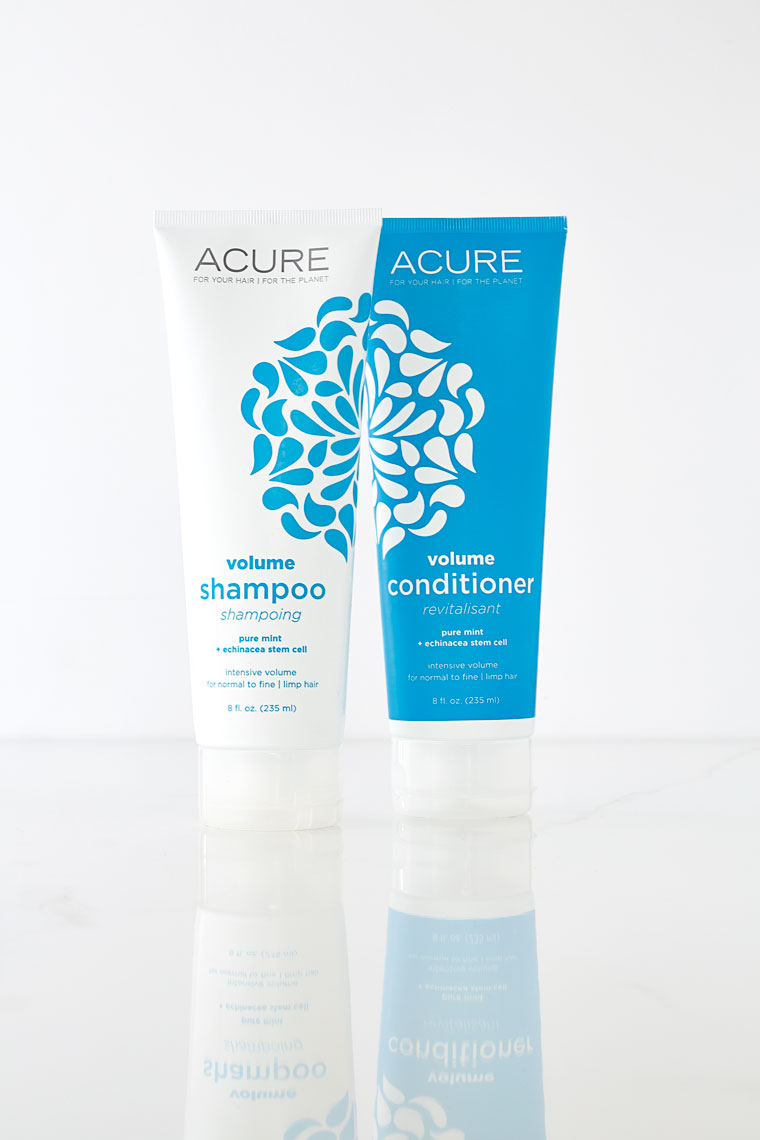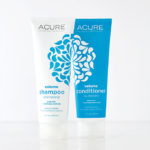
Acure: A solid shampoo for lather addicts afraid of No Poo
Two weeks ago I published this review on Acure’s Shampoo & Conditioner line. It read a bit differently than it does now. The review included full disclosure on the chemicals I questioned in Acure’s formulas, accompanied by Acure’s response speaking to these chemical’s safety. But the statements I received from Acure were not entirely accurate. In fact, some aspects were flat out untrue.
Most of what I said still holds true: Acure remains no worse than the majority of natural hair care lines, and they offer a reasonably priced product that works well. But their product is not as squeaky clean as Acure, or many other commercial green beauty lines, would have us believe.
I chose to review Acure because I felt that it was important to talk about a personal care brand who’s products are reasonably safe–a thousand times less-toxic than conventional drug store brands–while also reasonably priced.
I recognize that not everyone can afford to go either 100% artisanal, or alternatively has the time and headspace to go 100% homemade. However, my aim is to recommend products that I feel are either 100% safe or truthfully reveal any risks.
I was upset to have been betrayed by a company who I had perceived as producing an ethical product, and worse, embarrassed to have been involved in publishing mistruths. Fortunately, this turn of events has proven perfect fodder for the kind of informational lemonade that will help us as consumers of natural products to become better informed about green beauty.
What you should know
Although Acure mislead me about the innocence of their botano-chemical compounds, they did offer some valuable information that people using conventional products need to be aware of.
A few reasons why you should never buy conventional shampoos, or other chemical beauty products:
- Ingredients manufactured from synthetic sources are often contaminated with toxins.
- Ingredients manufactured from synthetic sources produce chemical by-products that increase their toxicity, such as: 1,4 dioxane and other formaldehyde donors.
- Synthetic preservatives are often formaldehyde donors by design–that is that they’re chemically bound to formaldehyde and designed to release it into the formula at a specific rate.
- Some formaldehyde donors to look out for include: DMDM hydantoin, diazolidinyl urea, imidiazolidinyl urea, and quaternium 15.
- Hazardous byproducts like formaldehyde don’t have to be listed on ingredient lists since they were not a physical ingredient added to the formulation.
Misrepresented botano-chemicals in Acure’s formulas
Although Acure does not use petroleum based chemicals, it turns out that their botanically derived compounds intended to produce lather, conditioning and other reactions may be more hazardous to the body than I expected.
This has been a reminder of what I’d learned many years ago–that surfactants and other chemicals produced from botanical raw materials such as coconut can still be toxic to the the body. Just because it says “derived from such-and-such fruit” does not mean it’s unequivocally safe.
Several days after publishing the post, I received a reply from QAI (via their parent company NSF) about Acure’s assertions. Although Acure only made claims that Behentrimonium Chloride (their “quat” ingredient) and Guar Hydroxypopyltrimonium Chloride are approved for use in NSF certified formulas, what I learned extended beyond these ingredients.
If you’re not familiar with QAI, Quality Assurance International is a USDA-accredited certifying agency for Organic foods and personal products. As a subsidiary of NSF, they’re monitored by the USDA National Organic Program and offer four different levels of Organic Certification for makers of beauty products.
It turns out that of all the chemical compounds that I was concerned with, cetearyl alcohol is the single one of the lot that meets the lowest NSF/ANSI 305 standard–one which basically lands U.S. made products within the range of E.U. approved conventional products. Cetearyl alcohol is in fact, as had been stated by Acure, a fatty alcohol with a low toxicity rating.
This is pretty troubling because NSF is a private company that straddles the line between shareholder interests and consumer safety. They work with the USDA, but their tiered certification criteria is not as stringent as that of the USDA Organic label for beauty products, allowing for botanical chemical processes that make for more sellable products.
All the other chemical ingredients that Acure claimed as harmless are prohibited in NSF/ANSI 305 products certified by QAI. In particular, the “quat” ingredient that Acure specifically cited as meeting NSF standards.
The NSF Standard expressly prohibits compounds with names containing:
- “quaternary”
- the suffix “-onium”
- the suffix “-taurate”
QAI has not been requested to review/approve Sodium Lauroyl Methyl Isethionate; however, it is not currently made through an allowed botano-chemical process.
Given this information, the following ingredients in Acure’s formulas are not deemed safe enough to meet NSF/ QAI standards.
- Sodium Laurel Methyl Isethionate: coconut-derived surfactant, provides “lather”.
- Sodium Methyl Cocoyl Taurate: coconut-derived surfactant, an alternative to sulfates.
- Guar Hydroxypopyltrimonium Chloride: guar gum conditioner.
- Behentrimonium Chloride: “quat” ingredient, conditioner.
If NSF draws the line at these ingredients, then so will I.
New go to’s
This information caused me to reevaluate my options and inspired me to give the No Poo method another shot. I am just thrilled with the results this time around! This toxin-free vinegar and baking soda method is a great option for people on a budget and for those who need unequivocally toxin free hair care. Get the full scoop in my post: No Poo How To
If you’re still not warmed up to the idea, consider pure-but-pricey organic shampoos like Living Libations, or the slightly more affordable Morocco Method line. If the big jump in price compared to Acure just doesn’t work for you – read on.
What remains true
When you parse the formulas of almost any hair care line available at health food stores or Whole Foods, you’ll find at least a few chemical ingredients. Some of these will follow with parentheses specifying the natural raw material source, such as beet or coconut, but just because the chemical is derived from a wholesome botanical source, doesn’t make it safe after it’s been processed into a chemical compound.
Compared to the majority of brands that market their products as natural, Acure stood out to me because the ratio of chemical compounds to whole ingredients was pretty low, and very consistent. Many natural bath and body lines, make one product with safe ingredients, yet another with the inclusion of harsh chemicals (of the synthetic variety described above). This did not seem to be the case with Acure.
When is Acure a safer bet?
Whether you’re using a low-end or high-end conventional shampoo, Acure will be a much safer option for you.
It may also be much cleaner than other naturally skewed shampoos. Just compare labels. The fewer chemicals and the lower they rank in the formula list, the better.
Acure is a safer alternative to these “natural” brands:
- Alba
- Nature’s Gate
- Jason
- Desert Essence
- Whole Foods 360
- Any generic grocery store brand
Pros for Acure:
- Shampoo and Conditioner, both work really well–leaving hair light and clean, but not stripped.
- Shampoo was gentle enough to relieve my hair from requiring conditioning after each wash.
- Ingredient standards are consistent throughout the product line.
- Made of largely discernible botanical ingredients, such as plant extracts, aloe or essential oils.
- Chemical compounds are made from botanical raw materials.
- Far safer to use than any conventional brand.
- Safer than many so-called “natural” brands close to the same price point.
- There are no gluten ingredients.
- Affordable – $6.15 at Thrive Market
Shampoo Ingredients
Organic Euterpe oleracea (Acai) Berry, Organic Rubus fruticosus (Blackberry), Organic Rosa canina (Rosehips), Organic Punica granatum (Pomegranate), Organic Fair Trade Certified™ Rooibos, Organic Aloe Barbadensis Vera Leaf Juice, Sodium Lauroyl Methyl Isethionate (from Coconut), 100% Naturally-derived Betaine (from Sugar Beets), Vegetable Glycerin, Sodium Methyl Cocoyl Taurate (from Coconut + Amino Acids), Sodium Cocoyl Glutamate (from Coconut + Amino Acids), Cocoglucosides Hydroxypropyltrimonium Chloride (Sugar Conditioner), Sodium Levulinate (from Corn), Guar Hydroxypropyltrimonium Chloride (Guar gum conditioner), Potassium Sorbate (food grade preservative), Organic Argania Spinosa (Argan) Oil, Organic Fair-Trade Certified™ Olea Europea (Olive) Oil, D-Alpha Tocopherol Acetate (vitamin E), hippophae rhamnoides (sea buckthorn) seed oil, Attalea speciosa(Babassu) oil, Chenopodium quinoa (Quinoa) protein extract, Ubiquinone (CoQ10), Echinacea angustifolia (Echinacea) Stem Cells, Mentha peperita (Peppermint) and Rosmarinus Officinalis (Rosemary) Essential Oils.
Conditioner Ingredients
Organic Euterpe Oleracea (Acai) Berry, Organic Rubus Fruticosus (Blackberry), Organic Rosa Canina (Rosehips), Organic Punica Granatum (Pomegranate), Organic Rooibos, Organic Aloe Barbadensis Vera Leaf, Vegetable Glycerin, 100% Natural Betaine (from Sugar Beets), Capric/Caprylic Triglycerides (Fractionated Cocos Nucifera (Coconut) Oil), Hydroxypropyl Starch Phosphate (from Non-GMO Corn Starch), D-Panthenol (Provitamin B5), Sucrose Laurate (from Sugar & Coconuts), Organic Olea Europaea (Olive) Fruit Oil (Extra Virgin), Ethyl Lauroyl Arginate (from Natural Amino Acid), & Natural Sclerotiom Gum (Fermented Sugar), Ubiquinone (CoQ10), Spinosa (Argan) Stem Cell, Organic Argania Spinosa (Argan) Oil, Argania Spinosa (Argan) Stem Cell Culture, Cymbopogon Schoenanthus (Lemongrass), Lavendula Dentata (French Lavender), Evernia Prunastri (Oakmoss), & Rosmarinus Officinalis (Rosemary) Essential Oils.




